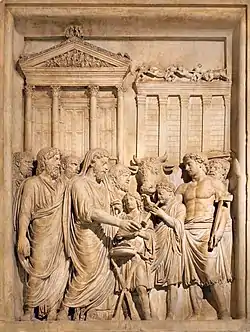| Dea Dia | |
|---|---|
Goddess of fertility and growth | |
| Festivals | Ambarvalia |
| Equivalents | |
| Greek equivalent | Demeter |
| Religion in ancient Rome |
|---|
 |
| Practices and beliefs |
| Priesthoods |
| Deities |
|
Deified leaders: |
| Related topics |

Bust of Lucius Verus wearing the headdress of an "Arval brother," who honoured Dea Dia at Ambarvalia.
Dea Dia (Latin: "Goddess of Daylight", or "Bright Goddess") was a goddess of fertility and growth in ancient Roman religion. She was sometimes identified with Ceres, and sometimes with her Greek equivalent Demeter.[1]
She was worshiped during Ambarvalia, a festival to Ceres.[2] Every May, her priests, the Fratres Arvales, held a three-day festival in her honor.[3][4]
Name
The name Dea Dīa (Classical Latin: [ˈd̪e.a ˈd̪iː.a]) means 'Goddess of Daylight' or 'Bright Goddess'.[5][6] The first element stems from the Latin dea ('goddess'), while the second is related to diēs ('day'), probably in reference to the ritual prescription to announce in January the May ceremonies sub divo culmine ('under the celestial vault').[5]
See also
- Other goddesses also known as Dea ("The Goddess")
- Other goddesses also known as Dia ("The Divine One")
References
- ↑ Michael Lipka (2009). Roman Gods: A Conceptual Approach. BRILL. pp. 64–. ISBN 978-90-04-17503-7.
- ↑ Hildegard Temporini (1 December 1985). Aufstieg und Niedergang der römischen Welt: Geschichte und Kultur Roms im Spiegel der neueren Forschung. Walter de Gruyter. pp. 1949–. ISBN 978-3-11-008289-0.
- ↑ Notes on Strabo's account, 5.3
- ↑ Angelo Pellegrini (1865). Gli edifici del collegio dei Fratelli Arvali nel lugo della dea dia e i di loro avanzi: opuscolo corredato con pianta delineata dal medesimo. tipografia Chassi. pp. 6–.
- 1 2 Schilling 1992, pp. 113–114.
- ↑ Jenkyns 2013, p. 96.
Bibliography
- Jenkyns, Richard (2013). God, Space, and City in the Roman Imagination. OUP Oxford. ISBN 978-0-19-967552-4.
- Schilling, Robert (1992). "The Arval Brethren". In Bonnefoy, Yves (ed.). Roman and European Mythologies. University of Chicago Press. ISBN 978-0-226-06455-0.
Further reading
- Price, S. R. F. (1992). "The Arval Brothers". The Classical Review. 42 (2): 341–344. doi:10.1017/S0009840X00284060. JSTOR 713240. S2CID 246879606.
- Brinton, D. G. (1892). "The Etrusco-Libyan Elements in the Song of the Arval Brethren". Proceedings of the American Philosophical Society. 30 (139): 317–324. JSTOR 983355.
- Kilgour, Andrew (1938). "The Ambarvalia and the Sacrificivm Deae Diae". Mnemosyne. 6 (3): 225–240. JSTOR 4426866. ProQuest 1299139937.
This article is issued from Wikipedia. The text is licensed under Creative Commons - Attribution - Sharealike. Additional terms may apply for the media files.
